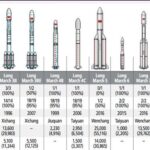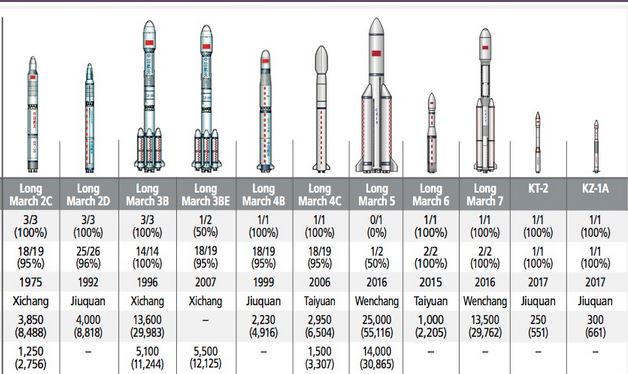Orbital Payload Launch
Chinese Payload Launches
2017 – China Payload Launch – Snapshot


China’s share of global orbital launch activity fell from its 2016 high of 26% to 20% for 2017. The nation’s 18 launch attempts moved it down in global launch activity ranking from . . .
2016 – China Payload Launch – Snapshot
China’s share of the global orbital launch market for 2016 matched that of ### and exceeded all other launch providers. The nation’s launch rate of ## in 2016 was the highest number of launch attempts China conducted and the first time the country went over ## launches in a single year. China successfully carried out the first flights of…
2015 – China Launch, Payload
China’s share of the global orbital launch market in 2015 nearly matched that of the United States. China accounted for slightly more than 22% of the global orbital launch market. China’s SLV launch rate of 19 for 2015 helped the country maintain its position in the global launch industry from 2014. Even though China launched two new SLVs in 2015, there were no known failures of Chinese SLVs in 2015 and 2014.
2014 – China Launch, Payload
China’s 2014 rate of ## launch attempts surpassed its 2013 total by ##. China’s launch vehicle family of choice was the Long March, and all ## of China’s launches were successful as they deployed a variety of military and civil spacecraft. One of China’s newest launch vehicles was previously expected to undertake its first flight in 2014.
2013 – China Launch, Payload
China’s launch rate in 2013 fell by ##% compared to the previous two years, when China set a national record for number of orbital launches. Of China’s ## orbital launch attempts in 2013, ## were successful and deployed a variety of military, civil, and crewed spacecraft.
2012 – China Launch, Payload
In 2012, China continued to outpace the United States in number of orbital launches, making ## orbital launch attempts in 2012, all of which were successful. This makes 2012 the second consecutive year in which China has surpassed the United States as the world’s second-most active launch operator, due primarily to China’s accelerating progress in deploying new scientific and communications satellites, and continued steady deployment of its Beidou satellite navigation constellation.
2011 – China’s Launch efforts – Snapshot
China’s annual total of ## flights surpassed its previous record of ## launches set in 2010. Additionally, 2011 marked the first year that China conducted more orbital launches than the United States, which performed ## launches in 2011. China’s increased launch rate over the last two years was mainly attributable to launches that placed satellites for China’s Beidou navigation system into orbit.
2010 – China’s Launch Efforts – Snapshot
China began the year with only a few missions publicly disclosed, but a series of unannounced launches in the second half of the year made 2010 China’s busiest year ever in terms of launch activity, exceeding its previous national record of ## launches in 2008. While China had only launched ## rockets by the end of July, it carried out ## launches in the following three months.
2009 – China Launch and Payload – Snapshot
China has long relied on the Long March (Chang Zheng) series of rockets to meet its orbital launch needs. With the Long March 1 series now retired, the Long March 2 and 3 series constitute the bulk of the Chinese rocket fleet, while the Long March 4 series serves smaller payloads.
2008 – China Launch, Payload
China’s increasing participation in space continued in 2008 with the record high of ## orbital launches, exceeding its previous peak of ## orbital launches in 2007. These launches used China’s only operational vehicle family, the Long March (“Chang Zheng”, or CZ) series.